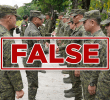DAVAO CITY — Nena Laurente, an elementary school principal, makes it a point not to drop students from her school, Vidas Cocuera Elementary School in Panacan.
Once in a while, she hears teachers report of students being absent for more than a week. But instead of approving their recommendation to drop absentee students, she asked teachers to check them in their homes.
“I asked them, have you asked these kids what have they been doing? Have you see them at their homes? Let us go make home visits,” she told her teachers.
When the teachers went on home visits, they found the reason why.
“When the students are cutting classes, they were actually in the market selling food or scavenging in garbage bins for food,” she said.
Laurente said child labor has been a concern for teachers, as many would drop out in the middle of the school year or not show up the following year, as they opt to find work to augment the family’s income.
Davao City’s Social Welfare Office recorded 264 child workers including market vendors, scavengers and pedicab drivers.
But the child rights group Kaugmaon (Future) for Children’s Rights and Social Development recorded 383 cases of child laborers in three commercial-industrial areas barangays Tibungco, Ilang, Panacan such as port extras, fertilizer carriers and cleaners of products and as harvesters in the agro-industrial barangay of Callawa all in the second district.
Laurente’s challenge was to make these children stay in school. But she has to do it with the help of both parents and teachers.
She first consulted parents during homeroom meetings why their children were either absent or tired in classes.
“It was a good thing the parents confessed their children were working as child laborers. That’s the start,” she said.
Laurente, who was trained by World Vision Foundation to value child-friendly environment in schools, managed to strike a good compromise to make children continue to support their families without jeopardizing their education.
“We had to allow some absences among these students, like two absences in a week only. But they had to attend catch-up classes on Saturdays,” she said.
She said they have volunteer teachers from Singles for Christ and Couples for Christ for the Saturday classes.
Laurente posted a tarpaulin in campus outlining the Conventions on the Rights of the Child in Cebuano.
She also had to educate fellow teachers how to handle students who worked during the rest of the day.
“If I hadn’t educated fellow teachers on child labor, there would have been many dropouts. It’s not fair to punish students,” she said.
Laurente had a soft spot for child workers, as she herself experienced growing up selling deep-fry bananas and suman as a student.
“When I was in college, I had a big bag with me. But what’s inside where fried bananas that I would sell to my schoolmates,” she recalled. “That’s why I would understand if children would doze off in class; I experienced that too.”
Laurente said there were no drop-outs in her school.
This school year, Laurente was transferred to the neighboring Bunawan Elementary School. Teachers and barangay officials are asking her to bring that same program she had in Cocuera to help absentee students.
“In the academe, it’s impossible to eradicate child labor. We can only minimize it,” she said.
Meanwhile, Kaugmaon director Florie Tacang noted that the government’s anti-poverty program, 4Ps, does not sufficiently address the child labor problem.
“Parents conceal to us that their children are working, as they fear they might lose their benefits from 4Ps,” she said.
Kaugmaon made a study last year that revealed only two of ten children in the city have been beneficiaries for 4Ps.
Labor statistics have pegged some 114,000 child laborers in the four provinces in Davao Region. Across the country, there are 3.9 million child laborers.
Child Alert Mindanao director Bernie Mondragon cited that the country is weakest in implementing child labor laws to protect children from working excess hours and that interferes with their social needs and education.
He stresses that curbing child labor entails that the community should be educated as the first line of defense.
“The community – the parents, barangay officials, schools — should be the first to address this issue. Or else it will be too late to stop them when they are already at work,” he said.
The German-based humanitarian group AWO International also supported this endeavor by funding Kaugmaon’s program to curb child labor.
“But remember, child labor can never be eliminated by a project or by Kaugmaon alone. It’s a task of the whole society,” said AWO International Southeast Asian Region Director Martin Liberantz.
The efforts of Kaugmaon have taken them to work with local officials from barangay to the city level, educators and government agencies.
“Our challenges have been to address poverty, address the culture that child labor is okay, and the lack of implementation of laws and services for the children,” said Tacang.
Their group recently held a stakeholders meeting with barangay and city officials with business sectors to monitor and curb child labor in their area.(davaotoday.com)










